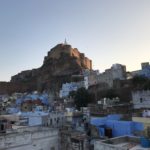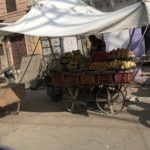Mumbai to Jodhpur – 935 km (train)
& 44176 Fit Bit steps
As we were both keen to see the colored cities of Jodhpur and Jaipur in Rajasthan first, we decided to head north and then make our way clockwise around the country. The 17-hr overnight train ride from Mumbai to Jodhpur was comfortable in our two-berth compartment and we were well-looked after, with people coming by regularly selling chai and snacks. A conductor took orders for dinner, presumably to be picked up at the next stop, which was one of the best vegetarian Thali meals we have had so far.
Jodhpur was still relatively quiet at 6:00 a.m. as a tuk tuk (auto rickshaw) took us through the narrow streets to our guest house. Climbing up to the rooftop balcony of the Singhvi Haveli, we had our first view of the immense Mehrangarh Fort, dominating Jodhpur’s skyline, and now lit by sunrise. The old town with its indigo blue houses looked enchanting in the early morning light. As we were gazing out over this scene and chatting by FaceTime with our daughter and her family in Victoria, the haunting sound of a Hindu morning prayer began broadcasting from a nearby temple. Later, those same streets were bustling with people, dogs, motorcycles, auto rickshaws, barrows and cows and shopkeepers, minding a multitude of very small shops, and sellers with carts carried on their trades.
The Mehrangarh (Mehran Fort) is one of the largest and most magnificent forts in India. Built in 1460 by the ruling Rathore clan of Rajputs when their 1000-yr old fort at Mandore was no longer defensible, it was occupied by Rajput Maharajahs for centuries, although at times under control of the Mughals, the Marathas, and later, the British. While Rajput clans ruled throughout what is now known as Rajasthan for centuries, they also fought amongst themselves, as evident from an expansion of the fort in the 19th century after an attack from Jaipur was repelled. Most of the major Rajput families accepted independence in 1947, but Rajasthan only became fully incorporated into the Indian federation in the 1970’s.
Still owned by the Jodhpur royal family, Mehrangarh is a beautifully maintained and exquisite example of Rajput architecture, with finely carved stone latticework and a network of courtyards. The fort’s former palace now houses an excellent museum, including a display of very fine miniature painting.
Braving the jostling throngs down in the town, we found an oasis of quiet at the Tunwarji ka Jhalra (step-well) and the adjoining Stepwell cafe where we found espresso, before again immersing ourselves in the hectic Sardar Market around the century old Clock Tower.
We booked two day tours from Jodhpur, one to local villages to visit a Muslim potter making traditional vessels for keeping water cold and, in another village, where a family carried on the tradition of making double sided kilim carpets by hand. Our second tour took us out into the scrubby Thar Desert that surrounds Jodhpur. Here, we rode on camels to a remote village, where we had a delightful lunch with the family running the trek and home-stay. The young son is setting up an AirBnB in the family’s village.
















